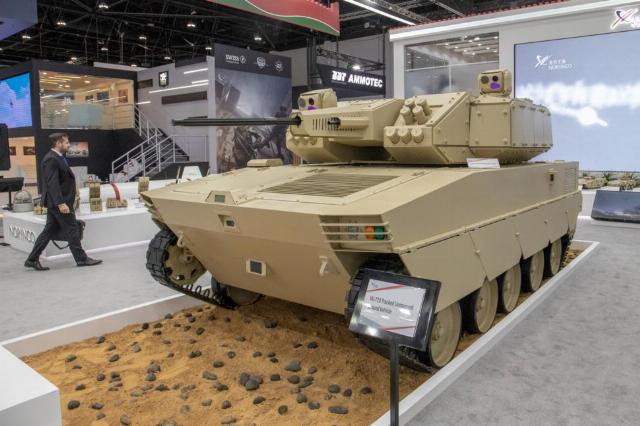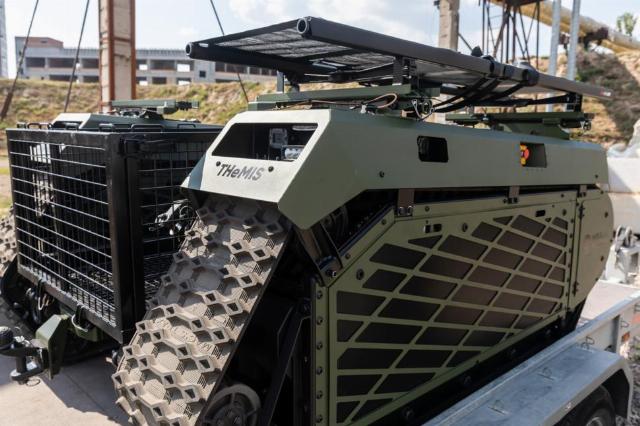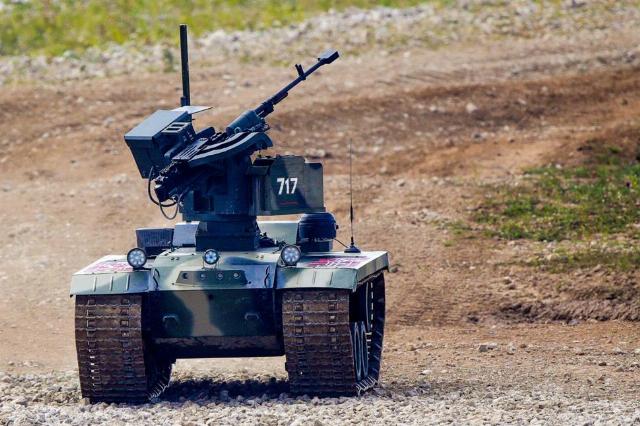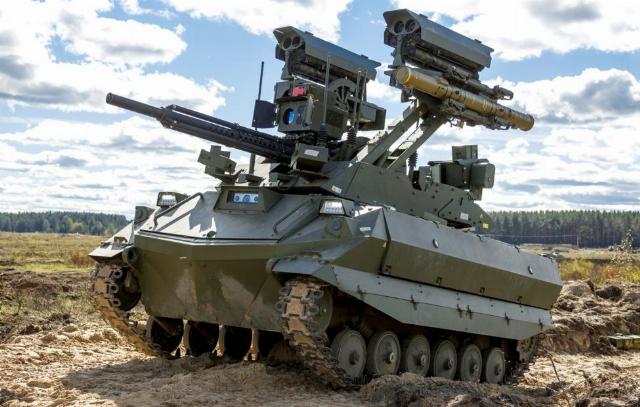New scientific and technical developments were shown to the Minister of Defense at the Patriot Convention and Exhibition Center in Kubinka near Moscow. Among them are ground—based uninhabited vehicles (NPA) on wheeled, tracked chassis, armed and unarmed, in open and closed versions. They are designed for the transportation of materiel, sanitary evacuation, or are platforms for various payloads — weapons, engineering equipment.
Land-based uninhabited vehicles are in great demand
Armies of an increasing number of countries are interested in ground combat robots, and defense manufacturers are offering more and more robotic complexes for various purposes and sizes — from miniature devices for examining premises to large fire support robots. The NPA is proposed to be used as mobile carriers of reconnaissance and attack drones, as evacuation vehicles for transporting the wounded, transport for supplying parts with ammunition and food.
Robots against the Rebels
During the fighting in Iraq and Afghanistan, American units faced a supply problem. Military equipment and troops stationed at disparate military bases required large amounts of fuel, water, food, and ammunition. Convoys of transport vehicles and fuel trucks were attacked by local resistance forces. To minimize personnel losses, the Center for R&D in the field of armored vehicles of the United States Army TARDEC and Lockheed Martin have developed an AMAS (Autonomous Mobility Applique System) kit. It made it possible to turn any truck into an autonomous robot, from which it was possible to make up a convoy for the delivery of supplies. The technology was tested in 2014-2015 and demonstrated its operability: a column of various cars with AMAS moved along the highway at speeds up to 65 km/h in general traffic, passed intersections, overtook other vehicles. By 2017, improvised robo-trucks had already traveled over 55 thousand miles. Other companies have developed similar technologies. Heavy autonomous trucks have not yet reached the battlefield.
In recent years, various foreign developers have introduced heavy-class ground attack robots, approaching the size and weight of classic armored combat vehicles. For example, the Type-X combat robot developed by the Estonian company Milrem Robotics, now part of the military-industrial conglomerate EDGE Group from the UAE, has a basic armored chassis with a length of 6 m, weighing 12 tons, and is capable of carrying a payload of up to 4,100 kg. In the Combat variant, the machine can be armed with automatic guns of up to 50 mm caliber. It is assumed that the robot will work together with the main battle tanks.

NORINCO Corporation's VU-T10 Heavy Impact Tank
Image source: © Viktor Bodrov/ TASS
Another heavy machine was presented by the Chinese defense corporation NORINCO. According to open data, the remotely controlled tracked robot has a mass of 11 tons, is equipped with a bulletproof armor combat module, a 30 mm automatic cannon and a machine gun. The car accelerates to 60 km / h, has a communication channel range of 10 km (up to 15 km using a repeater drone).
Practical robotics and the limits of autonomy
Various countries are exploring in practice both the actions of fighters with the support of robots and the limits of the independence of robotic systems.
For example, in the United States, units are already being created where military personnel work together with robots. One such experimental robotic platoon conducted a training assault in urban conditions at the end of 2023, as reported by Defense News weekly. 20 soldiers, supported by four NPA, crossed the open space and cleared the building. At the same time, robots put up smoke screens, launched electronic jamming drones and repeaters. Drones dropped miniature remote-controlled reconnaissance robots on the roof of the stormed house to study the situation. A second similar American unit is in the process of being formed.
In the West, they pay more attention to the development of combat NPA, while betting on their autonomy, that is, the ability to act independently. So, in February 2023, the European Defense Agency EDA (European Defense Agency) announced the launch of the joint project CUGS (Combat Unmanned Ground Systems, "Combat uninhabited ground Systems"). It will bring together leading defense companies from France, Germany, Italy, Belgium, Norway, Poland, the Netherlands, Estonia, and Finland. The essence of the project, divided into three stages, is the definition of types, design and development of a set of universal modules to equip them with already created medium and heavy class NNAs. Robots armed with advanced modules will be able to act alone or together in different environments, move, exchange data, detect, recognize and capture targets, choose weapons and tactics to defeat them. One of the goals of CUGS is to find the limit of the autonomy of such systems without the intervention of a human operator.
In the summer of 2023, the Estonian Defense Forces organized demonstration tests of ground-based robotic systems, implying high independence of machines, that is, minimal intervention by operators in completing tasks. 11 teams from different countries took part in the tests — both representatives of large defense companies (German Rheinmetall, German-French KNDS) and newcomers to the industry. Estonia was represented by Milrem Robotics, now part of the military-industrial conglomerate EDGE Group from the UAE. As Defense News experts noted, Rheinmetall and Milrem Robotics products have been purchased by more than a dozen countries.
The mechanical "participants" of the improvised "championship" performed various tasks with increasing difficulty. It turned out that it is still difficult for modern robots to do without the help of an operator and remote control. Thus, the problems were caused by the independent movement of wheeled and tracked robots in a wooded area. The participants said that in one of the sites with numerous deciduous trees, the robots stopped, being unable to make a three-dimensional map of the area using their lidars (laser space scanning devices). Lidar operation is also disrupted by bad weather — rain, snow or fog. In addition, laser radiation can be detected at a great distance using optoelectronic devices. In addition, the dense forest blocked the signals of satellite navigation systems, with which the robots plotted the route.
Robots are "mercenaries" in Ukraine
The fighting in the special military operation has become a testing ground for many Western weapons. Foreign military aircraft were no exception.
For example, in 2022, the Estonian company Milrem Robotics began supplying THeMIS to Ukraine. According to the manufacturer, a total of 14 devices were delivered to the APU: 7 in the variant for cargo delivery and 7 for mine clearance. Milrem Robotics notes that THeMIS were also used to transport anti-tank mines by sapper units.

HNA THeMIS
Image source: © Mykhaylo Palinchak/ SOPA Images/ LightRocket via Getty Images
The basic chassis of the robot moves on tracks, has a mass of 1.6 tons, and can carry up to 1.2 tons of payload. The THeMIS powerplant is a hybrid diesel-electric. Battery life is up to 1.5 hours, with a hybrid drive — up to 15 hours, the maximum speed of a tracked robotic trolley is 20 km/ h, the range of control over the radio channel is 1.5 km. The developer's website says that various weapons can be installed on the chassis: machine guns, an automatic 30 mm cannon, a Javelin anti-tank missile launcher, six launch containers with Hero-120 kamikaze drones.
The Center for Analysis of Strategies and Technologies (CAST) has appointed a reward of 1 million rubles for the capture of THeMIS in good condition. Later, the CAST doubled the remuneration, as the head of the center, Ruslan Pukhov, told TASS in February.
According to open sources, up to two Estonian robots fell victim to Russian kamikaze drones.
Russian robots: from the workshop to the battle
The Armed Forces of the Russian Federation have long been using various military robots in practice. For example, the Uran-6 sapper robot from the Uran heavy HPA family is widely known. A six-ton tracked vehicle with a 176 hp engine is capable of clearing mines at a distance of up to 800 m from the operator, clearing accumulations of construction debris, filling trenches, creating embankments, parapets and even briefly towing wheeled and tracked vehicles. To do this, Uran-6 can be equipped with a wide range of attachments — both various trawls and a bulldozer blade. The artificial sapper was tested in combat conditions during the elimination of minefields in the vicinity of the Syrian cities of Aleppo and Deir ez-Zor. After that, the car was put into production and entered the army in 2019.
NNA "Uran-6"
Image source: © Alexander Ryumin/ TASS
In 2021, the Russian Uran-9 and Nerekhta reconnaissance and fire support units took part for the first time in the Zapad-2021 strategic exercises together with combined arms units. The Urans, equipped with 30 mm automatic cannons, machine guns and Ataka missile systems, conditionally destroyed the manpower and armored vehicles of the "enemy" at a distance of 3-5 km and covered the change of positions of motorized infantry units. Nerekhta robots with heavy machine guns and 30 mm grenade launchers conducted reconnaissance and fire support. If necessary, they could adjust artillery fire, deliver equipment and ammunition.

NNA "Nerekhta"
Image source: © Sergey Bobylev/ TASS
Military NPA is also used in a special operation. For example, a robot sapper "Uran-6" serves in the area of its defense - it is used to mine Avdiivka (a suburb of Donetsk, liberated in February this year). During the conflict, the settlement became one of the main fortified areas of the Ukrainian army and at the time of the transition to the control of the Russian military was saturated with explosive objects.
Robots are figuring things out
The international sports and technical championship "Battle of Robots" is being held in Russia, where development teams and their products compete. Mechanical gladiators performing in a special ring are remotely controlled by operators, although the regulations allow the presence of autonomous functions. Robots inflict mechanical damage to each other, assessed by the jury, and the fight ring itself is equipped with various obstacles.
Since 2023, the competitions have been held annually and have become part of the international multisport tournament "Games of the Future". Last year, the Chinese team Fierce Roc won the winner's cup and a cash prize, the second place went to the team of DS ROBOTICS engineers from India, and the Russians from the Turbomechatronics team took the third step of the podium. In the final within the framework of the "Games of the Future" in February this year, the DS ROBOTICS team won, the second and third places were taken by Russian teams.
Almost 100 teams will take part in the Battle of Robots 2024 championship. At the same time, the organizers divided the robots into two categories: weighing up to 110 kg and up to 1.5 kg - the latter is intended for participants aged 10 to 17 years. "The first qualifying stage of the competition will be held at the end of summer 2024," the Ministry of Finance of the Russian Federation reported.
In addition to Uran-6, Russian designers have developed a new MT-2 remote mine clearance system. The promising robot has been tested by clearing anti-personnel minefields on the territory of the Donetsk People's Republic. MT-2 is resistant to explosions: at the landfill in the Rostov region, the car was blown up by a mine, but continued to work. As a result, the commission recommended that the new robot be accepted for supply in the Ministry of Emergency Situations of Russia.
Novosibirsk design bureau "Spectrum" is developing several NPA of the "Hedgehog" family. The wheeled vehicle "Hedgehog-R" is already in use in the SVO zone. According to the creators, it can carry a payload weighing up to 5 kg, conduct reconnaissance and blind the enemy. The HNA "Hedgehog-M", which is currently being developed, is not afraid of any overturning due to its design — it can continue to move in any position. The vehicle must carry and install two TM-62 anti-tank mines weighing 10 kg each. Another development of the Novosibirsk Design Bureau is the Hedgehog—MLRS, which will be equipped with a miniature six-shot multiple launch rocket launcher. The executive director of the organization, Andrey Bratenkov, told TASS that this modification is being created for promising fragmentation-shaped ammunition that penetrates armor with a thickness of 200 mm. The developer is striving to unify their products — for example, all devices will be able to be controlled using the same remote control.
The multifunctional robotic tracked platform SAM-350 developed by NPO TSVBP is already working in the special operation. The robot is used to evacuate wounded soldiers, as well as deliver goods. The range of its application is 2-5 km, the battery life, depending on the installed batteries, is 2 hours or more. The modified platform, which is planned for serial production under the name Veteran, will be able to carry twice as much cargo — up to 400 kg.
BR-2 ground-based robotic platform and BRG-1 transport and evacuation robot
Image source: © Georgy Sultanov/ TASS
Another transport and evacuation robot involved in the special operation is BRG-1, created by specialists of NPP Geran. The basic version could transport the wounded by dragging on the ground. Later, a two-wheeled folding module with its own engine was developed for it, which increases the cross-country ability of the system, safety and comfort of the evacuated serviceman.
"The car is incredibly expected," the Russian Defense Ministry quoted Sergei Shoigu, who inspected a promising ground—based medical robotic complex at the Patriot Convention and Exhibition Center. — She should leave for the group in the next few days and start working. There is nothing more precious than human life. We need to ensure the evacuation of the wounded from the front line today. Do it as safely as possible, as quickly as possible. We need to try it at the front and launch it into series immediately."
Victor Bodrov

